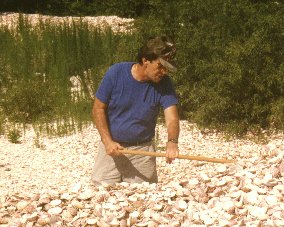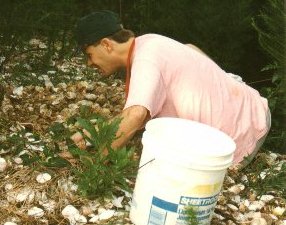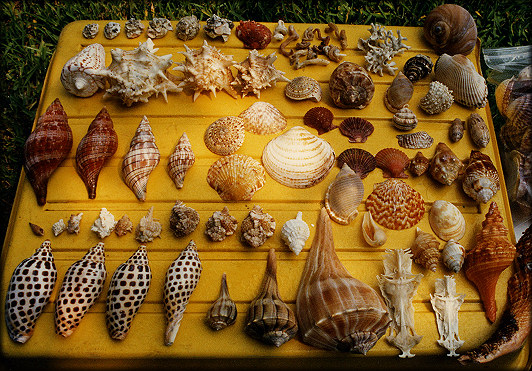| Snakes, Shells, And Sunshine |
| By Bill Frank |
| The weekend
of June 29th, eleven enthusiastic members of the Jacksonville
Shell Club (Bill and Betsy Lyerly, Kaye and Mike Noble, Rob
and D. D. Jewell, Andy Hutchison, Selma Thigpen, Betty Hunter,
Leigh Murphy, and Bill Frank) traveled to the much slower paced
environment of the Florida Panhandle to assess recent
developments in the areas scallop fishery. Headquarters for the
trip was the Georgian Motel in downtown Carrabelle. Six of the group (Bill and Betsy, Selma, Andy, Betty, Leigh, and your Editor) left Jacksonville early Friday morning to facilitate exploration of potential dump shelling sites for the next day. The first site, the Carrabelle Dump, was scouted by Bill L., Bill F., and Leigh. Because of its remoteness in the middle of nowhere, some concern was expressed about the likelihood of encountering snakes. Bill Lyerly, a budding amateur herpetologist, reassured the group by stating that snakes would always flee from a human encounter when they detected the vibrations of an approach. So much for that hypothesis. The first thing encountered after exiting Leigh's 4-wheel drive vehicle was a four-foot long snake lying in the middle of the path to the scallops. Despite the presence of three not so quiet shellers, the serpent just lay there apparently relishing its new found importance. Leigh promptly identified it as a black racer (non-venomous), at which point it quickly exited the area. Despite being quite overgrown with weeds from lack of use, the dump, as in previous visits, appeared to offer great potential. The next stop was Buddy Ward's Dump north of Apalachicola, which according to the owner, contained little in the way of scallops. However, several small mountains of scallops were present. After about 45 minutes of investigation by the entire group, it became obvious that the material had been culled as little other than scallops was found. |
|
|
|
Bill Frank attacks the scallop pile at Buddy Ward's Dump. |
| During the
return to Carrabelle, the ebbing minus tide had exposed many
acres of sand flats so an impromptu investigation was in order.
The flats subsequently yielded numerous species of both live and
crabbed shells including the abundant Melongena
corona altispira (Crown Conch) and many
smaller species. With the time rapidly slipping away, it was time to get on the road to Julia Mae's Restaurant in Carrabelle to rendezvous with the late arrivals (the Jewells and Nobles). Following a delicious meal, it was back to the motel to rest up, and for some, a quick swim in the pool. Later that evening, a few inquiries at a local hang-out (the corner convenience store) revealed that no scallop harvesting was currently taking place and that none had taken place in quite some time. This was borne out by the lack of any new material in any of the dumps since the club's previous organized visit during the Spring of 1995. Up early Saturday morning, it was off the Carrabelle Dump for several hours of excavating. The dump lived up to expectations by yielding numerous desirable shells including the ever present Scaphella junonia (Junonia), Triplofusus giganteus (Florida Horse Conch), Cassis madagascarensis spinella (Clench's Helmet) Murex fulvescens (Giant Atlantic Murex) (one over seven inches in length and in excellent condition), large paired Lyropecten nodosus (Lions Paw), paired Aequipecten muscosus (Rough Scallop) in a wide variety of colors including lemon yellow, as well as many other offshore species. |
|
|
|
Rob Jewell gets down and dirty at the Carrabelle Dump. |
| Also found
amongst the scallops was an additional serpent which bore more
than a casual resemblance to a coral snake; a colorful and shy
venomous Florida resident. Again it was Leigh, obviously quite
knowledgeable in all things serpent, who identified the critter
as a harmless look-alike. With the temperature rapidly
increasing, it was back to the motel to recuperate before setting
off to the Port St. Joe scallop dump. Upon arrival at the Port St. Joe Dump it was learned that the whole facility had recently been sold and the new owner, due to past bad experiences, had decided to ban shellers completely. After some dialog, the new owner referred the group to another individual (a Pharmacist in Port St. Joe) who possessed scallop material. As it turned out, that person was none other than the owner of the Mexico Beach scallop mountain; an individual who the club had encountered during a previous visit under less than optimum circumstances. Although congenial, because of potential liability problems, he too denied access to his property. With the hopes of shelling any further scallop dumps now dashed, it was off to St. Joseph Bay to explore the miles of grass/sand flats which had been exposed by the days minus tide. However, the only live species seen were Crown Conchs, probably due in part to the bathtub like temperature of the water. So it was back to Carrabelle to relax and enjoy an evening meal prior to the evenings minus tide. A majority of the group then visited the same sand flats just west of Carrabelle Beach that had been shelled the previous day. With darkness quickly approaching, the flats were virtually alive with shells. The live finds included large Neverita duplicata (Shark-eye Moon), Florida Horse Conch, Neoterebra dislocata (Atlantic Augur), Sinun perspectivum (Common Baby's Ear), Prunum apicinum (Common Atlantic Marginella), Oliva sayana (Lettered Olive), and a wide variety of other small species (Natica, Olivella, Epitonium, etc.). The next morning it was up early for the return to Jacksonville with everyone quite pleased with their finds and happy to have had the opportunity to visit this unique area of Florida - "The Forgotten Coast". |
|
|
|
A selection of shells from the Carrabelle Dump |


